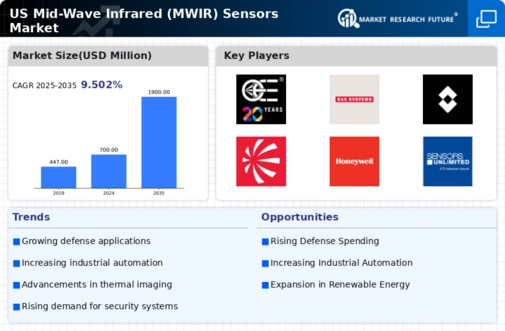Rising Defense Expenditure
The mid wave-infrared-mwir-sensors market is likely to benefit from the increasing defense budgets in the US. As national security concerns escalate, the government appears to allocate more resources towards advanced surveillance and reconnaissance technologies. This trend is evidenced by a projected growth in defense spending, which is expected to reach approximately $800 billion by 2026. Such investments are anticipated to drive demand for mid wave-infrared-mwir-sensors, which are crucial for military applications, including target acquisition and threat detection. The integration of these sensors into various defense systems may enhance operational capabilities, thereby fostering growth in the mid wave-infrared-mwir-sensors market.
Emerging Applications in Healthcare
The mid wave-infrared-mwir-sensors market is witnessing growth due to emerging applications in the healthcare sector. These sensors are increasingly utilized for non-invasive medical diagnostics, particularly in monitoring body temperature and detecting various health conditions. The healthcare industry in the US is projected to reach $4 trillion by 2026, indicating a substantial market for innovative technologies. The integration of mid wave-infrared-mwir-sensors into medical devices could enhance patient care and streamline diagnostic processes. As healthcare providers seek to adopt advanced monitoring solutions, the mid wave-infrared-mwir-sensors market is likely to expand in response to these evolving needs.
Growing Interest in Renewable Energy
The mid wave-infrared-mwir-sensors market is likely to see increased demand driven by the growing interest in renewable energy sources. As the US transitions towards sustainable energy solutions, the need for efficient monitoring and management of energy systems becomes paramount. Mid wave-infrared-mwir-sensors can play a vital role in the optimization of solar panels and wind turbines by providing critical data on temperature and performance. The renewable energy sector is expected to grow significantly, with investments projected to exceed $500 billion by 2030. This shift towards cleaner energy sources may create new opportunities for the mid wave-infrared-mwir-sensors market, as stakeholders seek advanced technologies to enhance energy efficiency.
Advancements in Industrial Automation
The mid wave-infrared-mwir-sensors market is experiencing a surge due to the rapid advancements in industrial automation. Industries are increasingly adopting automated systems to enhance efficiency and reduce operational costs. The integration of mid wave-infrared-mwir-sensors into automated processes allows for precise temperature monitoring and quality control, which are essential in manufacturing environments. The market for industrial automation in the US is projected to grow at a CAGR of around 10% over the next few years, indicating a robust demand for technologies that can support these systems. Consequently, the mid wave-infrared-mwir-sensors market is poised to expand as industries seek to implement more sophisticated monitoring solutions.
Increased Focus on Research and Development
The mid wave-infrared-mwir-sensors market is expected to benefit from an increased focus on research and development (R&D) initiatives. Various sectors, including defense, healthcare, and industrial automation, are investing heavily in R&D to innovate and improve existing technologies. This trend is reflected in the US government's commitment to funding research projects, with an estimated $200 billion allocated for R&D in 2026. Such investments are likely to foster advancements in mid wave-infrared-mwir-sensors, enhancing their performance and expanding their applications. As new technologies emerge, the mid wave-infrared-mwir-sensors market may experience significant growth driven by these R&D efforts.


















Leave a Comment